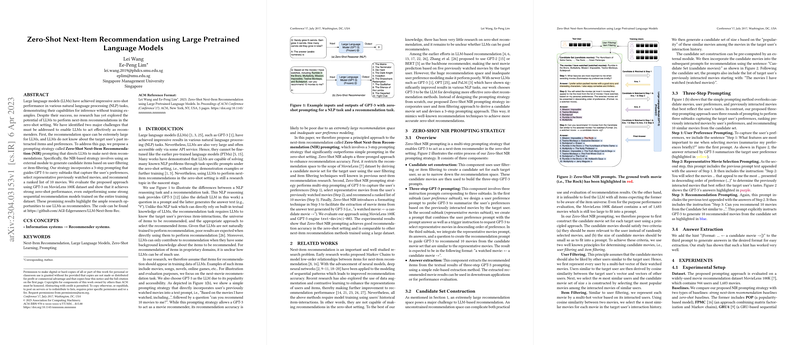Zero-Shot Next-Item Recommendation Using Large Pretrained LLMs
The paper "Zero-Shot Next-Item Recommendation using Large Pretrained LLMs" presents a novel approach that leverages the capabilities of LLMs to address a challenging problem in recommender systems: making next-item recommendations without any example demonstration or additional training. This research systematically explores the applicability of LLMs to perform zero-shot next-item recommendations, specifically leveraging GPT-3, a state-of-the-art LLM.
Core Contributions
The paper identifies two primary obstacles when applying LLMs to recommendation tasks: the potential enormity of the recommendation space and the lack of user-specific historical interaction data. To address these challenges, the authors propose a "Zero-Shot Next-Item Recommendation" (NIR) prompting strategy, utilizing a multi-step approach fundamentally different from simplistic single-prompt strategies previously explored.
- Candidate Set Construction: This process dramatically narrows the recommendation space by selecting a subset of potentially relevant items for each user using user filtering and item filtering. By representing users and items as vectors and calculating cosine similarities, the candidate set is determined based on popularity and similarity metrics, ensuring this subset is manageable in size while relevant to the user.
- Three-Step Prompting Strategy: This strategy encompasses a sequence of prompts designed to guide GPT-3 through capturing user preferences, identifying representative user-interacted items that best reflect these preferences, and finally recommending new items from the candidate space. Each step leverages the intermediate results to fine-tune the subsequent prompt, effectively guiding the model's reasoning process.
- Answer Extraction: To handle GPT-3's output, a format-based method is utilized, ensuring that the model's textual recommendations can be efficiently parsed and integrated into the recommendation system.
Empirical Evaluation
The proposed method's effectiveness was tested on the MovieLens 100K dataset, and it demonstrated significant promise as a zero-shot recommendation approach. Notably, the NIR methods saw performance metrics such as HR@10 and NDCG@10 showing competitive results not only against simple zero-shot prompting baselines but even surpassing certain models that were fully trained on the dataset. This highlights NIR's potential in scenarios where training data is scarce or non-existent.
Furthermore, the careful design of a principled strategy to reduce the candidate item set, along with the multi-step prompting, was shown to improve performance over simple or random selection methods significantly. Additionally, the impact of tuning the candidate set size was explored, evidencing the trade-off between candidate set comprehensiveness and recommendation precision.
Implications and Future Directions
By demonstrating that LLMs can perform effectively in zero-shot recommendation tasks, this research potentially shifts how recommender systems can be designed, especially in context-rich domains where user-specific training data might not be feasible to collect.
Future work could extend this methodology across different domains and explore how richer interactions (beyond simple watch history) can be incorporated into LLM prompts. Additionally, investigating few-shot learning scenarios could offer a productive middle ground between zero-shot settings and full model training, providing pathways for more nuanced and customizable user experiences.
In conclusion, this research provides a compelling look into the adaptability of LLMs beyond traditional NLP tasks, showcasing their potential in operational domains like recommender systems without necessitating time-consuming pretraining or fine-tuning processes. The implications for practical applications are manifold, laying groundwork for more flexible, responsive, and less data-intensive systems across industries reliant on recommendation algorithms.
